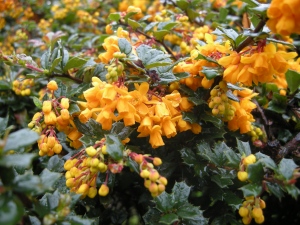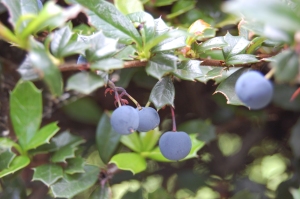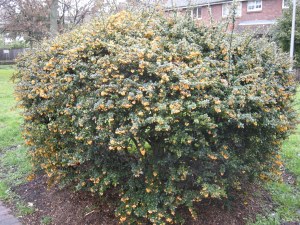Position: Full sun
Soil: Moist, well drained
Flowering period: Spring
Eventual Height: 3m
Eventual Spread: 3m
Hardiness: 7a, 7b, 8a, 8b, 9a
Family: Berberidaceae
Berberis darwinii is an evergreen shrub with an upright habit and a vigorous growth rate. Its dark green leaves are obovate, spine-toothed, glossy and up to 25mm long and 12mm broad. It bears a profusion of pendant racemes, composed of dark orange flowers in mid spring and occasionally again in autumn. Following these are spherical blue/ black fruit.
Berberis darwinii, commonly known as Darwin’s Barberry and Michay, is native to southern South America. Charles Darwin discovered the plant in South America in 1835. The berries are edible but quite biter.
The etymological root of the binomial name Berberis is latinised from the Arabic برباريس,. Darwinii is also a latinised form of the surname of Charles Darwin. B. darwinii is considered to be an invasive species in New Zealand.
The landscape architect may find Berberis darwinii useful as an informal hedge or specimen shrub. The spines along its shoots will also make this plant highly useful for barrier planting and can be used against building edges to provide defensible space to ground floor windows. Container grown plants should always be specified.
Ecologically, Berberis darwinii will attract pollinating insects with its nectar and pollen and will cater for birds with its fruit.
Berberis darwinii prefers moist, fertile, well-drained soils. It tolerates most pH of soil.
The Royal Horticultural Society have given Berberis darwinii their prestigious Award of Garden Merit in 1993.
Berberis darwinii requires little care, dead or damaged material may be removed after the plant has finished flowering.








IS IT POSIBLE TO TAKE CUTTINGS FROM A BERBERIS BUSH? YOURS FAITHFULLY, DAVID.
David, I believe semi- ripe cuttings are the best way to propagate. http://apps.rhs.org.uk/advicesearch/Profile.aspx?pid=404
Good luck.